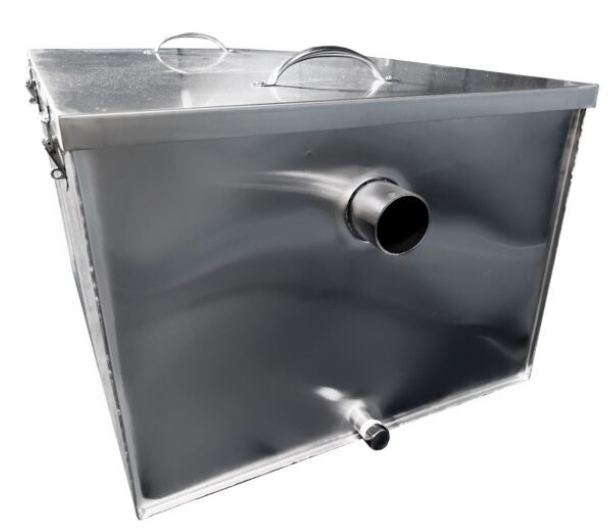
Grease management is a critical aspect of running a safe and efficient restaurant or takeaway kitchen. Proper handling of fats, oils, and grease (FOG) is essential to prevent blockages in plumbing systems, maintain kitchen hygiene, and comply with environmental regulations.
Any business that generates FOG (fats, oils and grease) should be employing strict grease management practices as well as installing a suitable grease trap. No matter how efficient and effective your grease preventative measures are, FOG will still find a way to make it into mains drainage systems.
Firstly let's take a look at effective grease management practices that every restaurant and takeaway kitchen generating FOG should follow.
Grease Management Practices for Commercial Kitchens
1. Implement a FOG Control Plan:
Develop a comprehensive FOG control plan that outlines procedures, responsibilities, and best practices for FOG management. Train kitchen staff to follow this plan diligently.
2. Educate Staff:
Provide thorough training to all kitchen staff regarding FOG management, including proper disposal techniques, the importance of scraping plates, and the use of designated FOG containers.
3. Use Strainers in Sink Drains:
Install strainers in sink drains to prevent food debris from entering the plumbing system, reducing the potential for clogs.
4. Scrape and Wipe Dishes:
Before washing, scrape excess food scraps from dishes and wipe them with paper towels to remove residual FOG. Dispose of the scraps and dirty paper towels in a designated container.
5. Implement Dry Wiping:
Dry wipe kitchen surfaces and equipment regularly to remove FOG build-up, which can attract pests and create fire hazards.
6. Dispose of FOG Properly:
Collect FOG and quantities of used cooking oil in designated, sealed containers and arrange for its proper disposal through licensed waste disposal services or recycling programs where available.
7. Regular Cleaning and Maintenance:
Routinely clean kitchen exhaust hoods, ducts, and fans to prevent FOG build-up and avoid fire risks. Schedule professional cleaning as needed to comply with local regulations.
8. Monitor Plumbing System:
Regularly inspect the plumbing system for signs of blockages or backups. Address any issues promptly to prevent costly repairs and disruptions.
9. Implement Best Practices for Dishwashing:
Use low-phosphate detergents that minimise FOG build-up in wastewater. Ensure dishwasher filters are cleaned regularly.
10. Use Biodegradable Cleaning Products:
Choose biodegradable and environmentally friendly cleaning products to reduce the environmental impact of cleaning and FOG disposal.
11. Maintain Records and Logs:
Keep detailed records of FOG disposal, maintenance activities, and cleaning schedules. This documentation helps demonstrate compliance with regulations.
12. Comply with Local Regulations:
Familiarise yourself with local laws and regulations related to FOG management and comply with them diligently to avoid fines and penalties.
13. Train for Emergency Response:
Train staff on how to respond to FOG-related emergencies, such as grease fires or major spills, to ensure their safety and minimise damage.
14. Conduct Routine Audits and Inspections:
Periodically assess the effectiveness of your grease management practices through internal audits or third-party inspections, making necessary adjustments as required.
By adhering to these effective grease management practices, restaurants and takeaway kitchens can maintain a clean, safe, and compliant environment while minimising the environmental impact associated with FOG disposal. Proper FOG management not only ensures operational efficiency but also contributes to a responsible and sustainable business model.
Why It's Essential to Have a Suitable Grease Trap
Many businesses think that because they dispose of used cooking oil responsibly, and strictly adhere to strict grease management practices, they don't need a grease trap. This is not true!
While the majority of oil may be recycled appropriately and according to guidelines and legislations, there are many other ways that FOG can make it's way into waste water outlets. Think about residual grease, fats and cooking oil in pans and cookware, cooking utensils and on frying baskets. What about sauces and juices that remain on dinner plates when they are brought back to the kitchen? What's the first thing that staff do before these items go to be cleaned?
If a business is observing grease management techniques then they will wipe surfaces with a paper towel and dispose of in a bin. Other businesses may just head straight to the sink to swill off residue. Whichever path your business takes, it's inevitable that some FOG will be released into the main drains, whether that's from swilling and washing in the sink or via the waste water from commercial dishwashers, pot washers and utensil washers.
A correctly installed grease trap can substantially reduce a commercial restaurant or takeaway kitchens FOG output to almost nothing. To guarantee continued performance it's essential that the correct size grease trap be installed for the volume of water flowing through your kitchen and for how many sinks you have. Regularly inspection, cleaning and maintenance is also critical to ensure that traps continue to function optimally.
Regardless of whether you implement impeccable grease management practices or not, all businesses that produce FOG should have a suitable passive or manual grease trap, an automatic grease trap (GRU). Get in touch with your local water authority and work with them to get ahead of the curve rather than waiting for them to pursue action.


